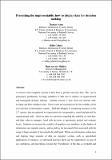Presenting the un-presentable: how to display data for decision making
Date
2008-10-20Author
Acton, Thomas
van der Heijden, Hans
Golden, William
Metadata
Show full item recordUsage
This item's downloads: 591 (view details)
Recommended Citation
Acton, T., Golden, W. & van der Heijden, H. (2008). Presenting the un-presentable: how to display data for decision making, In Proceedings of the 1st Irish Social Science Platform Conference, Dublin City University, Dublin, September.
Abstract
A concern with computer systems is how best to present onscreen data. This can be
particularly problematic for large quantities of data and in contexts of organisational
and managerial decision making. Another concern is how users can interact with,
navigate and filter displayed data. These issues are encompassed by the usability of the
user interface to information systems. With the ubiquity of computing resources in the
21st
century, data are gathered by organisations in vast quantities, stored and queried for
organisational ends. However there are questions regarding the usability of such data,
and their value to managers faced with decisions at operational, tactical and strategic
levels. Solutions to increase the usability of graphical user interfaces, to the display of
information on computer screens, and to address the increased effort associated with the
usage of large amounts of data need to be addressed. Where an information system uses
and displays large amounts of data on computer screens, such as spreadsheet
applications or database- or web-based searches, there can be compromises in ease of
use, usefulness, and perceptions towards the friendliness of the data as workable and2
appropriate for certain tasks. Sometimes it can be better to display data in aggregate
form, in tables or as charts, and with drill-down or exploratory opportunities for various
purposes; on the other hand for some decision making scenarios it can be better to
present and visualise data in their entirety, and can sometimes involve various kinds of
visualisation aids and display formats. Indeed, in decision-making usage scenarios
usability- or user performance shortcomings of various kinds of informational display
formats may be influenced by the type and usage of such formats and display
approaches, and compensated by software functionality that provides decision task
support. If such shortcomings can be addressed and compensated, perhaps through
support systems targeting improved efficacy or usability in terms of the usage of
information systems for decision-making tasks, or through approaches to matching
display formats with task, then the usefulness and user perceptions towards the
suitability and usability of data for critical or important organisational and managerial
function may be positively impacted. This paper discusses various approaches to data
display and presentation on information systems, and presents a discussion on the
suitability of presentation type for certain managerial decision-making tasks.


